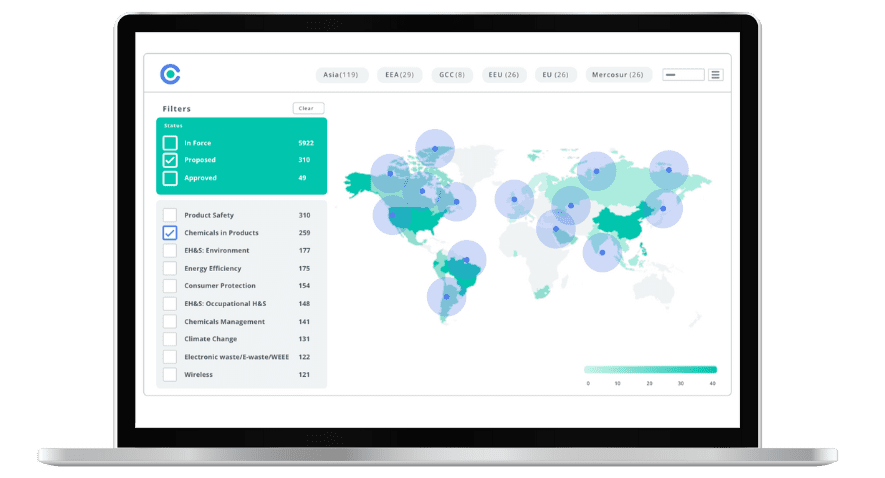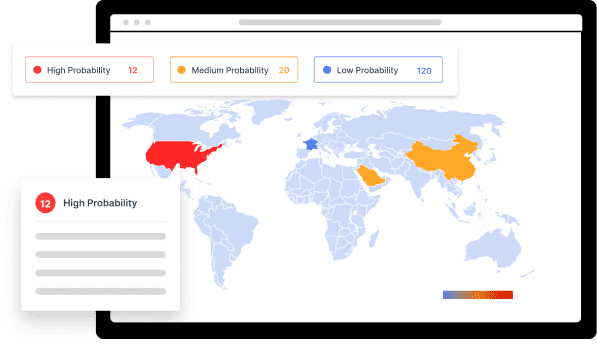
California’s 2026 Climate Reporting: What You Need To Know

This blog was originally posted on 29th July, 2025. Further regulatory developments may have occurred after publication. To keep up-to-date with the latest compliance news, sign up to our newsletter.
AUTHORED BY ALEX LI, REGULATORY COMPLIANCE SPECIALIST, AND CORINE LAURIJSEN, SENIOR REGULATORY COMPLIANCE SPECIALIST AND TEAM LEAD, COMPLIANCE & RISKS
In 2023, the US State of California enacted two important climate disclosure laws:
- Senate Bill (SB) 253, the Climate Corporate Data Accountability Act on reporting of greenhouse gas emissions scope 1, 2 and 3; and
- SB 261, the Climate Related Financial Risk Act on disclosing climate-related financial risk and measures adopted to reduce and adapt to this risk.
In 2024, the Acts were amended by SB 219, and in 2025, the California Air Resources Board (CARB) started an informal information-gathering for the development of regulations implementing the Acts.
As the first reporting period approaches, this blog will review the requirements and deadlines for reporting entities based on the Acts. It also discusses the implications of the FAQ document recently released by CARB as it relates to the scope and requirements of the reporting programs.
SB 253 – Reporting of Greenhouse Gas Emissions
To whom does this Act apply?
SB 253 applies to Unites States companies (“reporting entities”) with total annual revenues in excess of one billion dollars ($1,000,000,000) and that do business in California.
What needs to be reported?
Under SB 253, the following greenhouse gas emissions need to be reported:
- Scope 1 emissions – all direct greenhouse gas emissions that stem from sources that a reporting entity owns or directly controls, regardless of location, including, but not limited to, fuel combustion activities.
- Scope 2 emissions – indirect greenhouse gas emissions from consumed electricity, steam, heating, or cooling purchased or acquired by a reporting entity, regardless of location.
- Scope 3 emissions – indirect upstream and downstream greenhouse gas emissions, other than scope 2 emissions, from sources that the reporting entity does not own or directly control and may include, but are not limited to, purchased goods and services, business travel, employee commutes, and processing and use of sold products.
A reporting entity must obtain an assurance engagement, performed by an independent third-party assurance provider, of the entity’s public disclosure.
When is reporting starting?
Starting in 2026 on or by a date to be determined by CARB, and annually thereafter on or by that date, a reporting entity must publicly disclose to the emissions reporting organization, if contracted for services, or the state board, all of the reporting entity’s scope 1 emissions and scope 2 emissions for the reporting entity’s prior fiscal year, and obtain an assurance engagement of the public disclosure.
Starting in 2027 and annually thereafter, a reporting entity must publicly disclose its scope 3 emissions for the prior fiscal year on a schedule to be specified by CARB as part of the regulations.
How is a reporting entity supposed to measure and report its GHG emissions?
Beginning in 2026, a reporting entity shall measure and report its emissions of greenhouse gases in conformance with the Greenhouse Gas Protocol standards and guidance, including
- Greenhouse Gas Protocol Corporate Accounting and Reporting Standard and the Greenhouse Gas Protocol Corporate Value Chain (Scope 3) Accounting and Reporting Standard developed by the World Resources Institute and the World Business Council for Sustainable Development,
- Technical Guidance for Calculating Scope 3 Emissions that detail acceptable use of both primary and secondary data sources, including use of industry average data, proxy data, and other generic data in its scope 3 emissions calculations.
Want to dive deeper into global sustainability trends? Watch our recent webinars on Asia’s ESG & Sustainability Landscape: Compliance Essentials for 2025 and ESG Regulatory Developments in the US.
SB 261 – Disclosing of Climate-Related Financial Risk
To whom does this Act apply?
SB 261 applies to Unites States companies (“covered entities”) with total annual revenues in excess of five hundred million dollars ($500,000,000) and that do business in California.
A covered entity does not include a business entity that is subject to regulation by the Department of Insurance in California, or that is in the business of insurance in any other state.
What needs to be disclosed?
A covered entity needs to disclose its climate-related financial risk. This means the material risk of harm to immediate and long-term financial outcomes due to physical and transition risks, including, but not limited to, risks to:
- Corporate operations
- Provision of goods and services
- Supply chains
- Employee health and safety
- Capital and financial investments
- Institutional investments
- Financial standing of loan recipients and borrowers
- Shareholder value
- Consumer demand, and
- Financial markets and economic health
When is reporting starting?
Covered entities shall prepare the climate-related financial risk report and publish a copy on its own website on or before 1 January 2026 and biennially thereafter.
How is a covered entity supposed to disclose its climate-related financial risk?
Under SB 261, the following information needs to be reported in the form of a climate-related financial risk report biennially:
- Climate-related financial risk in accordance with the TFCD Final Report of Recommendations (June 2017) or its successors or other equivalent reporting frameworks;
- Measures adopted to reduce and adapt to the disclosed climate related financial risk.
If a covered entity cannot submit its report in accordance with the accepted frameworks outlined above, it shall instead provide the recommended disclosures to the best of its ability as well as describe in detail the reporting gaps and next steps in addressing them.
A covered entity is considered to have satisfied the reporting requirement if it prepares a publicly accessible biennial report which includes the relevant climate-related financial risk information disclosed in accordance with a law or regulation incorporating disclosure requirements consistent with SB 261 or voluntarily using a framework that meets the requirements, including the International Financial Reporting Standards (IFRS) Sustainability Disclosure Standards as issued by the International Sustainability Standards Board (ISSB).
SB 219 and Next Steps for Climate Disclosures in California
What changes does SB 219 introduce to climate reporting?
SB 219 does not change the overall reporting timeline and requirements as prescribed in SB 253 and SB 261. It does, however, introduce several notable changes that have implications on how climate reporting may be carried out and regulated in California. Specifically, SB 219:
- Delays the requirement that CARB shall adopt regulations from 1 January 2025 to 1 July 2025;
- Authorizes, rather than requires, CARB to contract with an emissions reporting organization to develop a reporting program to receive required disclosures and make certain required disclosures publicly available;
- Requires that the regulations adopted by CARB require, among other things, a reporting entity to make the annual disclosure to either the emissions reporting organization or CARB;
- Requires the reporting entity under SB 253 to publicly disclose its scope 3 emissions on a schedule specified by CARB, rather than no later than 180 days after its scope 1 emissions and scope 2 emissions are publicly disclosed;
- Authorizes both greenhouse gas emissions and climate-related financial risk reports to be consolidated at the parent company level;
- Deletes the requirement that the annual entity’s fee be paid upon filing the disclosure.
What are the latest updates from CARB regarding enforcement and rulemaking?
In December 2024, CARB issued an enforcement notice on SB 253 as amended by SB 219. It informs the public that CARB has decided to exercise enforcement discretion to refrain from enforcement action for incomplete reporting against entities, provided that they “make a good faith effort to retain all data relevant to emissions reporting for the entity’s prior fiscal year”, for the first report due in 2026. As per the notice, companies could use existing data gathered prior to the issuance of the notice for the initial emissions reports. This is, however, an indirect confirmation that CARB decided to proceed with the reporting deadlines as the Act originally prescribed.
CARB also sought to solicit feedback from the public in December 2024 regarding the applicability and scope of both Acts, the reporting standards to be used, the data reporting costs and processes, as well as specific questions related to both SB 253 and SB 261 on issues like scope 1, 2 and 3 emissions reporting, assurance providers, reporting thresholds and cycles, etc. The deadline for comments was originally 14 February 2025, which was extended to 21 March 2025.
CARB held a virtual public workshop in May 2025 to support the finalization of the California Corporate Greenhouse Gas Reporting Program and the Climate-Related Financial Risk Disclosure Program regulatory development. The presentation offered a timeline on the rulemaking process for climate disclosures. Currently CARB is at the “pre-rulemaking” stage where it gauges public and stakeholder inputs from informal workshops while also identifying regulatory concepts and discussing alignment with legislative intent. The next phase, “formal rulemaking”, will see CARB issue a notice of proposed rulemaking including the draft regulatory text, initial staff report, and environmental and economic analyses. A 45-day comment period is proposed to ensue and, if required, additional amendments may be proposed with a new 15-day comment period. CARB has one year to complete the final rule once the initial proposal is published according to law.
The virtual public workshop proposed the initial staff definitions for “revenue”, “doing business in California”, and for “parent” and “subsidiary” companies in the context of enforcing future regulations. The CARB is seeking input from stakeholders regarding these definitions and feedback should be sent to climatedisclosure@arb.ca.gov prior to the finalization of the regulations.The latest update from CARB with regards to climate disclosures is a Frequently Asked Questions (FAQ) document published on 9 July 2025 following the virtual workshop.
In the document, CARB confirmed that it is still “in the informal, information-gathering stage for implementing” the Acts, highlighting the efforts outlined above. This means that CARB was not able to meet the 1 July 2025 deadline for rulemaking as per SB 219. Nevertheless, CARB does clarify that it “is committed to developing a regulation by the end of the year [of 2025].” It also states that it would post a public docket for covered entities under SB 261 to post the location of the links to their first climate-related financial risk reports on 1 December 2025.
What Are the Key Takeaways?
Prepare NOW
Next year, companies that do business in California and fall under the climate reporting Acts will be required to disclose their climate-related financial risks and begin reporting their greenhouse gas emissions. The deadlines are here to stay, so it is time to start preparing now using the GHG Protocol and the TCFD reporting standard or similar frameworks.
Follow the rulemaking
While the final rulemaking has not been completed for climate disclosures in California and companies that fall under either or both climate reporting programs face significant uncertainties, they are not helpless against the incoming regulatory developments.
Instead, as CARB has been actively seeking public input for the adopted regulations, businesses should take the initiative to voice their opinions and let their perspectives be heard.
Seek help
Well-planned and sufficient preparation, targeted and meaningful engagement as well as accurate and timely tracking of developments are all indispensable for ensuring compliance with the California climate disclosure programs and many more ESG reporting requirements. Regulatory compliance tools like C2P can help alleviate the heavy burden by always staying ahead of regulatory change.
Stay Ahead Of Regulatory Changes in California’s 2026 Climate Reporting
Want to stay ahead of regulatory developments in California’s 2026 Climate Reporting?
Accelerate your ability to achieve, maintain & expand market access for all products in global markets with C2P – your key to unlocking market access, trusted by more than 300 of the world’s leading brands.
C2P is an enterprise SaaS platform providing everything you need in one place to achieve your business objectives by proving compliance in over 195 countries.
C2P is purpose-built to be tailored to your specific needs with comprehensive capabilities that enable enterprise-wide management of regulations, standards, requirements and evidence.
Add-on packages help accelerate market access through use-case-specific solutions, global regulatory content, a global team of subject matter experts and professional services.
- Accelerate time-to-market for products
- Reduce non-compliance risks that impact your ability to meet business goals and cause reputational damage
- Enable business continuity by digitizing your compliance process and building corporate memory
- Improve efficiency and enable your team to focus on business critical initiatives rather than manual tasks
- Save time with access to Compliance & Risks’ extensive Knowledge Partner network

US Product Compliance 2025: Key Federal & State Changes to Watch
Explore recent developments in US product compliance – with a particular focus on state-level legislation and trends to watch in 2025.



